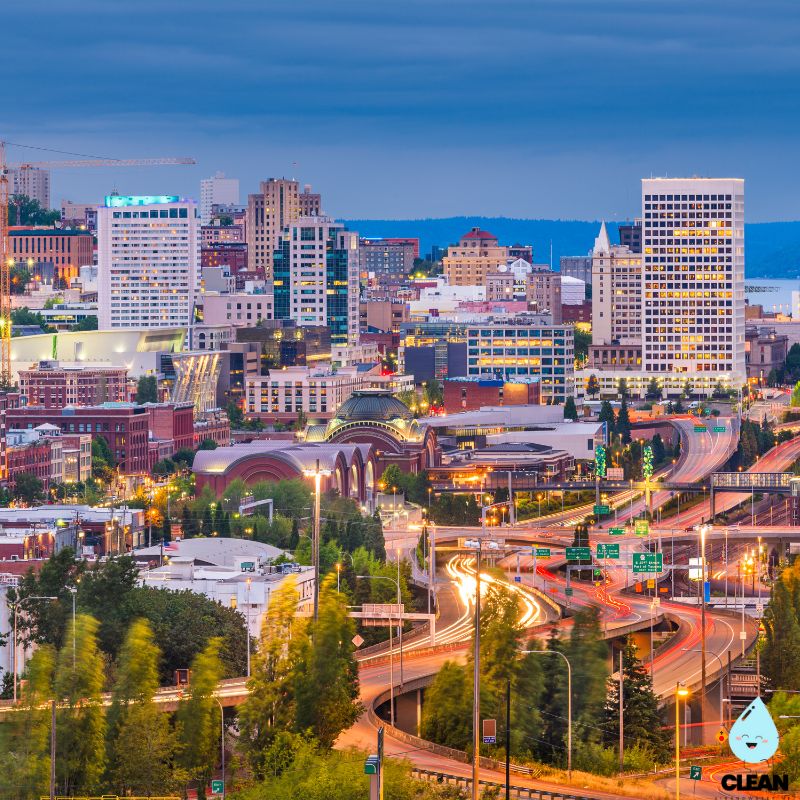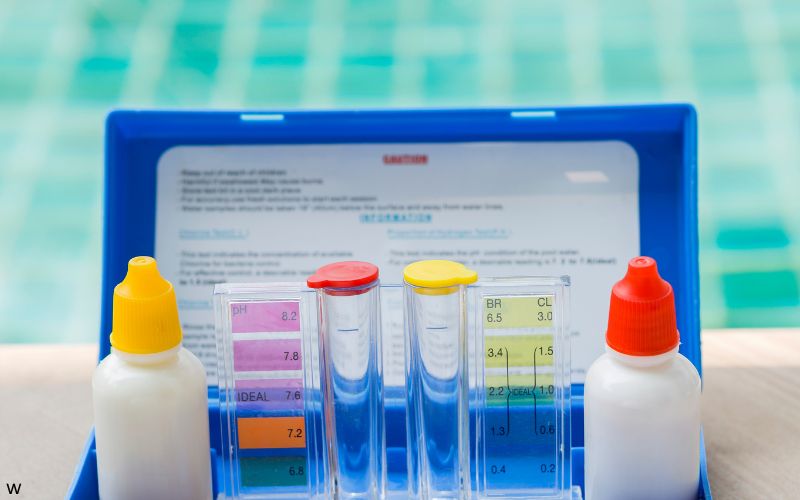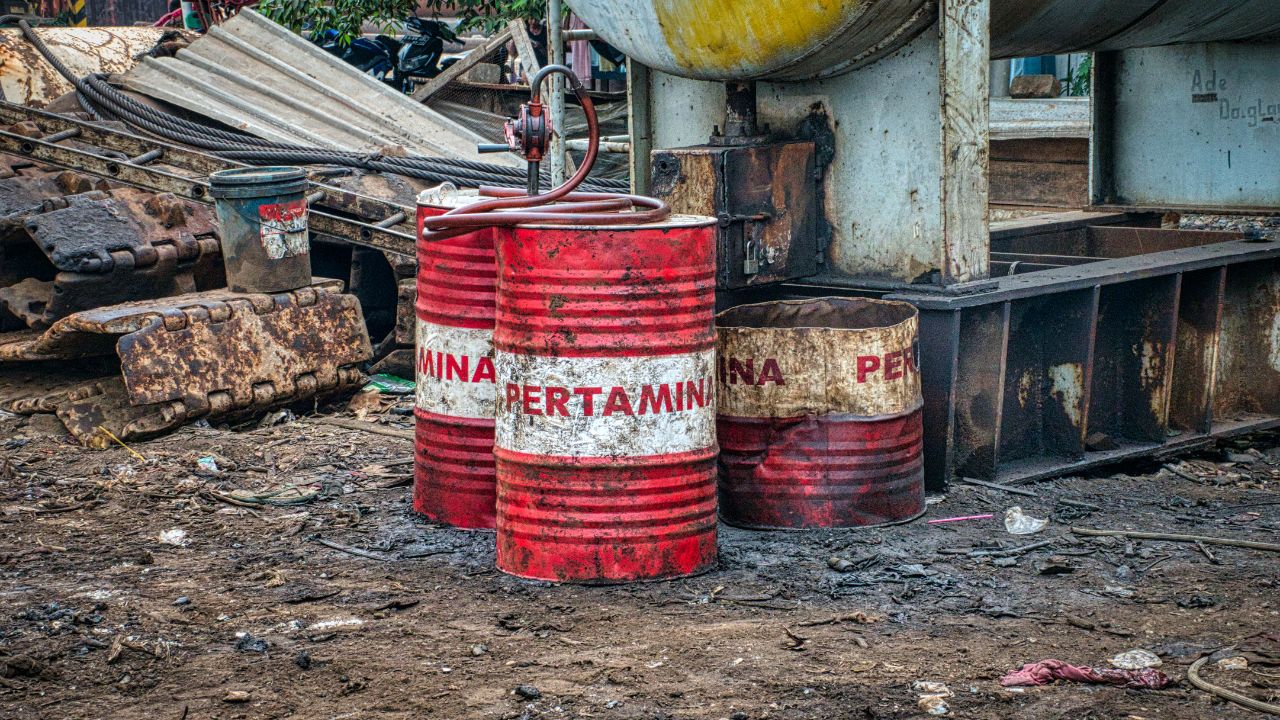Tacoma Water Quality at a Glance
11 contaminants exceed health guidelines
Is Tacoma Water Safe to Drink?
Generally Safe, With Some Concerns – Tacoma water meets federal standards and sources from the protected Green River Watershed. However, 11 contaminants exceed health guidelines, with key issues including arsenic at 91 times health guidelines, chloroform at 19 times guidelines, and total trihalomethanes at 65 times guidelines. These are primarily disinfection byproducts from chlorine treatment and naturally occurring minerals. PFAS has not been detected in the primary Green River supply.
⚠️ Key Concerns for Tacoma Residents
- Arsenic: Detected at 0.365 ppb (91x above health guideline); naturally occurring carcinogen in groundwater
- Disinfection Byproducts: Chloroform, bromodichloromethane, and trihalomethanes formed during chlorine treatment process
- Hexavalent Chromium: Cancer-causing chemical at 8.2x health guidelines from industrial pollution or natural sources
- Nitrates: Agricultural runoff contamination at 16x health guidelines, particularly concerning for infants
Read the full report below for detailed analysis, city-specific data, and actionable recommendations for Tacoma residents.
Tacoma – Washington – Water Quality Report 2025: PFAS Testing, Infrastructure Concerns & Safety across your city
Tacoma Public Utilities serves approximately 300,000 residents across the greater Tacoma metropolitan area, including portions of Pierce County and surrounding communities. Established in 1893 as one of the nation’s first publicly owned utilities, the system encompasses over 1,100 miles of water distribution lines, multiple treatment facilities, and extensive storage infrastructure that delivers an average of 55 million gallons of drinking water daily throughout the Pacific Northwest’s third-largest city.
Tacoma sources its drinking water primarily from the pristine Green River Watershed located in the Cascade Mountains foothills, with supplemental groundwater wells serving as backup supply. The Green River provides over 95% of the city’s water supply, treated at the state-of-the-art Green River Filtration Facility completed in 2015. While Tacoma’s water meets all federal and state quality standards, independent testing shows 11 contaminants exceeding health guidelines, with key concerns including arsenic at 91 times health guidelines, disinfection byproducts, and hexavalent chromium. The utility has implemented significant investments in advanced treatment technology, watershed protection, and customer assistance programs to ensure sustainable water service for future generations.

Tacoma Water Quality: Current Status (2024-2025)
Latest Testing Results
- PFAS Monitoring: Tacoma Water has conducted comprehensive testing for per- and polyfluoroalkyl substances, with no regulated PFAS chemicals detected in the Green River supply. Some groundwater wells in the region have shown PFAS contamination, particularly near Joint Base Lewis-McChord, prompting selective operation and blending strategies.
- Contaminant Concerns: Independent testing by EWG shows 11 contaminants exceeding health guidelines, including arsenic at 0.365 ppb (91x above health guideline), total trihalomethanes at 9.81 ppb (65x above guideline), and hexavalent chromium at 0.164 ppb (8.2x above guideline).
- Compliance Status: Tacoma’s water consistently meets all federal and state drinking water standards, maintaining full compliance with EPA and Washington State Department of Health regulations for all regulated contaminants despite exceeding stricter health guidelines.
Water Sources
- Green River Watershed: Primary source (over 95% of supply) located in the protected Cascade Mountains foothills, spanning approximately 65,000 acres of forestland with natural filtration through pristine wilderness areas managed under strict access controls.
- South Tacoma Wellfield: Backup groundwater supply from over 20 wells providing approximately 5% of annual supply, with increased use during peak demand periods or drought conditions. Some wells have been affected by regional PFAS contamination.
- Watershed Protection: Comprehensive Habitat Conservation Plan protecting fish and wildlife species while maintaining water quality through strict access controls and land management, with Tacoma Water owning key portions of the watershed.
Advanced Treatment Technology
- Green River Filtration Facility: State-of-the-art treatment plant completed in 2015 with capacity to filter 150 million gallons per day, utilizing advanced multi-barrier treatment including coagulation, flocculation, sedimentation, and granular activated carbon filtration to remove cryptosporidium and other contaminants.
- Disinfection Process: Chlorine disinfection provides pathogen protection throughout the distribution system, though this process creates disinfection byproducts including trihalomethanes and haloacetic acids that exceed health guidelines but remain below legal limits.
- Real-Time Monitoring: Continuous water quality monitoring throughout the treatment process and distribution system, with automated controls and alarm systems ensuring optimal treatment performance and immediate response to any variations.
Infrastructure Management
- Distribution System: Over 1,100 miles of water mains with ongoing replacement and upgrade programs focusing on aging infrastructure, leak detection, and pressure management to maintain system reliability.
- Storage and Pumping: Multiple reservoirs and pumping stations strategically located throughout the service area, including the recently decommissioned Portland Avenue Reservoir following the closure of the WestRock paper mill in 2024.
- PFAS Treatment Planning: Proactive development of treatment strategies for groundwater wells with detected PFAS levels, including engineering studies and implementation plans to ensure continued compliance with new federal regulations by 2029.
Customer Support and Conservation
Tacoma Public Utilities provides extensive customer support through various programs, including the Bill Credit Assistance Plan offering monthly credits for qualifying low-income households, payment arrangement options, and Budget Billing for predictable monthly payments. Conservation programs include rebates for water-efficient fixtures, smart irrigation technologies, and educational outreach to promote sustainable water use practices. The utility’s commitment to transparency includes regular water quality reports, public participation in planning processes, and responsive customer service available 24/7 for emergencies. With recent rate adjustments approved for 2025-2026 to address infrastructure needs and rising costs following the loss of major industrial customers, Tacoma continues investing in treatment technology upgrades, distribution system improvements, and source water protection to ensure reliable, high-quality drinking water for current and future generations.
Recommendations for Tacoma Residents

Monitor Water Quality
Stay informed about your water quality by reviewing Tacoma Water’s regular quality reports and contacting customer service at (253) 502-8600 for any taste, odor, or pressure concerns. Consider independent testing if you have private wells or concerns about specific contaminants like arsenic or disinfection byproducts.

Practice Water Conservation
Take advantage of Tacoma’s conservation rebate programs for water-efficient fixtures and appliances. Use drought-resistant landscaping and smart irrigation practices to reduce outdoor water use while maintaining beautiful gardens and lawns.

Consider Home Filtration
Given that 11 contaminants exceed health guidelines including arsenic and disinfection byproducts, consider NSF-certified reverse osmosis or activated carbon filters (Standard 53) for drinking and cooking water to reduce exposure to these contaminants.

Apply for Bill Assistance
Qualify for the Bill Credit Assistance Plan if your household income is at or below 60% of area median income. This program provides automatic monthly credits plus additional credits for on-time payments. Visit mytpu.org or call (253) 502-8400 for applications.

Report Water Issues
Contact Tacoma Public Utilities customer service at (253) 502-8600 for water quality concerns, pressure problems, or service interruptions. Emergency services are available 24/7 for urgent issues like main breaks or safety concerns.
Frequently Asked Questions
Is Tacoma’s tap water safe to drink?
Tacoma’s tap water meets all federal and state drinking water standards and is generally safe to drink. The city’s water comes primarily from the pristine Green River Watershed in the Cascade Mountains, which provides natural filtration through protected forestland.
However, independent testing shows that while legally compliant, Tacoma’s water contains 11 contaminants exceeding health guidelines, including arsenic at 91 times the health guideline, disinfection byproducts at 19-65 times guidelines, and hexavalent chromium at 8.2 times the guideline. The multi-barrier treatment process includes coagulation, sedimentation, granular activated carbon filtration, and chlorine disinfection. While the water meets regulatory standards, residents concerned about long-term exposure to these contaminants may consider filtration systems for drinking and cooking water.
What about PFAS in Tacoma’s water?
Tacoma Water has extensively tested for PFAS (per- and polyfluoroalkyl substances) throughout its system:
Green River Supply: No regulated PFAS chemicals have been detected in the Green River, which provides over 95% of Tacoma’s water supply
Groundwater Wells: Some backup wells in the region show PFAS contamination, particularly near Joint Base Lewis-McChord where firefighting foams have contaminated groundwater. Tacoma manages this by prioritizing Green River water and selectively operating wells with lower concentrations
Future Compliance: Tacoma is developing treatment plans for affected wells to ensure compliance with new EPA regulations taking effect in 2029
The utility’s proactive approach includes engineering studies and treatment system design to address PFAS before it becomes a regulatory requirement, ensuring continued safe drinking water for all customers.
Why are water rates increasing in Tacoma?
The Tacoma Public Utilities Board approved rate increases for 2025-2026 to address several factors:
• Infrastructure costs: Rising prices for materials and equipment needed for system maintenance and upgrades
• Major customer loss: Closure of WestRock paper mill in 2024 eliminated the utility’s largest commercial water customer, requiring rate adjustments to maintain system operations
• System improvements: Ongoing investments in treatment technology, distribution system upgrades, and compliance with new regulations including PFAS treatment
• Rate increases: Approximately 6% annually for water bills, resulting in roughly $3-$4 monthly increase for average residential customers
Tacoma offers assistance programs including payment plans, Budget Billing, and the Bill Credit Assistance Plan for qualifying low-income households to help manage utility costs.
How does Tacoma protect its water source?
Tacoma protects the Green River Watershed through comprehensive management strategies:
Land Protection: The 65,000-acre watershed is largely protected through federal, state, tribal, and private ownership, with Tacoma Water owning strategic holdings around key water sources
Access Control: Gates, guards, and agreements with federal, state, tribal, and private landowners strictly limit public and commercial access to minimize contamination risks
Habitat Conservation Plan: Long-term federal plan protecting fish and wildlife species while maintaining water quality through forest management and environmental monitoring
Natural Filtration: The rugged, remote terrain provides natural protection, with precipitation filtered through pristine forests before reaching the river
This multi-layered protection ensures Tacoma’s primary water source remains among the highest quality in the nation, requiring minimal treatment while supporting regional ecosystems.
Quality News About Your Water
Get the comprehensive water quality news coverage you need with our dedicated US Water News Service. From coast to coast, we deliver in-depth reporting and expert analysis on PFAS contamination, EPA regulatory changes, infrastructure developments, and emerging water safety issues affecting communities nationwide. While mainstream media only covers the biggest stories, we provide the detailed, ongoing coverage that helps you understand the full scope of America’s water challenges. Whether you’re a concerned citizen, water professional, or community leader, our daily updates and analytical insights keep you informed about the issues that matter most to public health and environmental safety.
Contaminants of Concern

PFAS Compounds
Source: Per- and polyfluoroalkyl substances from industrial processes, firefighting foams (particularly at Joint Base Lewis-McChord), and consumer products that can contaminate groundwater sources
Health Effects: Potential impacts on immune system, thyroid function, cholesterol levels, and increased risk of certain cancers with long-term exposure above safe levels
Current Status: No PFAS detected in Green River supply; contamination found in some regional groundwater wells, with treatment planning underway EPA Limits: New federal regulations for six PFAS compounds require compliance by 2029

Disinfection Byproducts
Source: Formed when chlorine disinfectants react with naturally occurring organic matter in source water; levels vary seasonally with temperature and organic content
Health Effects: Long-term exposure to elevated levels may increase risk of certain cancers and potentially affect liver, kidney, and reproductive system function
Current Levels: Total trihalomethanes at 9.81 ppb (65x health guideline), haloacetic acids at 3.81 ppb (38x guideline), chloroform at 7.80 ppb (19x guideline) – all below EPA legal limits but above health guidelines EPA Limits: 80 ppb for total trihalomethanes (TTHMs) and 60 ppb for haloacetic acids (HAA5)
Please read – our information
The information presented on cleanairandwater.net is compiled from official water quality reports, trusted news sources, government websites, and public health resources. While we strive for accuracy and thoroughness in our presentations, we are not scientists, engineers, or qualified water quality professionals.
Our mission is to present water quality information in an accessible, real-world format that helps people understand what’s in their water and make informed decisions about their health and safety. We believe that complex environmental information should be available to everyone in a format that’s easy to understand.
We make every effort to ensure our content is current and accurate, but we cannot guarantee that all information is complete or error-free. This website should not replace official communications from your local water utility or health department. We always recommend consulting official sources for the most up-to-date information regarding your specific water system.
Clean Air and Water is not liable for any unintentional errors, omissions, or outdated information. The content on this site is provided for informational purposes only and should not be considered professional advice.


